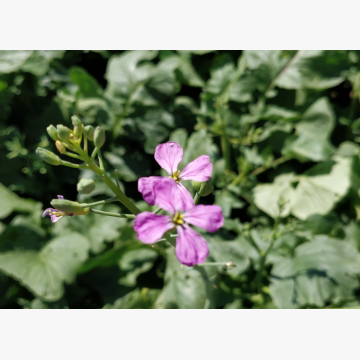- Home
- Seeds
- Catch/Cover crops
- Plants for catch/cover crops
- Fodder radish CARWOODI (H1)
Category: Catch/Cover crops
FOR CONSULTATIONS APPLY TO:
Commercial director
Lina Smalskienė
tel. +370 618 02 551
e-mail linak@agrolitpa.lt
Sales manager
Tautvydas Kliučininkas
tel. +370 681 35 093
e-mail tautvydask@agrolitpa.lt
Sales manager
Eglė Petkevičienė
tel. +370 626 95 458
e-mail eglep@agrolitpa.lt
Sales manager
Kotryna Nakrošytė
tel.: +370 601 39 282
e-mail kotryna@agrolitpa.lt
Products
Raphanus sativus var. oleiformis L.
A late tetraploid fodder radish, 1st class of resistance to beet cyst nematodes
- High biomass
- Tall plants
- Good lodging resistance
- Suitable for nematode control, biofumigation, soil improvement
- Developed for nematode control
- Wide range of nematodes to be destroyed
- Grows easily and rapidly in cool weather
- Produces a lot of biomass in 60 days
- Flowers – purple
- Contains high amounts of glycosides, which act as biofumigants, when incorporated into moist soil
- For the purpose of biofumigation, it should be incorporated before the flowering stage, at least 3-5 weeks before sowing following plants
- Controls the incidence of the nematode Meloidogyne chitwoodi (Columbia Root Knot Nematodes (CRKN)) when planted after harvesting potatoes or carrots
- The branching root system collects and binds a lot of nitrogen, protecting it from leaching
- Strong and deep root system. Many lateral roots, which are concentrated closer to the soil surface, improve soil structure and water infiltration
- Into soil incorporate biomass is food for microorganisms
- Grown as a green manure in potato and carrot crop rotations, reduces the amount of pesticides and synthetic biofumigants to control the nematode Meloidogyne chitwoodi (kills up to 90 % of these nematodes)
- Grown as a green manure in potato crop rotation, reduces pesticide and synthetic biofumigants for control of the nematode Meloidogyne rostochiensis (Potato Root Eelworm)
- Prefers well-drained soils with a pH of 6.4-7.3
- Many additional roots loosen the soil even better than the taproot of tillage radishes
- Viability/growth rate – fast
- Soil coverage – strong
- The height of the plants – medium
- Flowering time – late
- The amount of biomass – high
- Root system – many additional roots
- Type of rooting – deep
- Nitrogen accumulation in the plant –high
- Accumulation of phosphorus in the plant – high
- Accumulation of potassium in the plant – high
- Nutrient return – moderately high
- C/N ratio – low
The varietal parameters may differ from those indicated here when the testing circumstances differ from quondam
Recommended sowing rate when growing for seed production: 10-14 kg/ha, interrow spacing – 12-15 cm
Recommended sowing rate when growing for green manure: 25-30 kg/ha
UAB „Agrolitpa“
Keravos sreet. 17, Kerava,
LT-38 131 Panevėžys district, LITHUANIA
Enterprise's code 168598128
VAT code LT685981219
Tel. +370 615 11 315
E. mail info@agrolitpa.lt
Keravos sreet. 17, Kerava,
LT-38 131 Panevėžys district, LITHUANIA
Enterprise's code 168598128
VAT code LT685981219
Tel. +370 615 11 315
E. mail info@agrolitpa.lt




.JPG)


